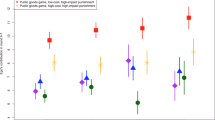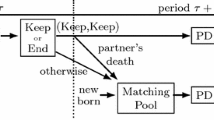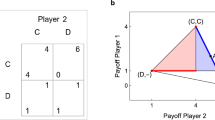Abstract
Given the difficulty of observing interpersonal relations as they develop within an organization, I use iterated prisoner&2018;s dilemma games to simulate their development. The goal is to understand how trust could develop as a function of private games, that is, as a function of interaction sequences between two people independent of their relationships with other people. My baseline is Axelrod&2018;s results with TIT for TAT showing that cooperation can emerge as the dominant form of interaction even in a society of selfish individuals without central authority. I replicate Axelrod&2018;s results, then show that the results only occur in a rare social context&2014;maximum density networks. Where people form less dense networks by withdrawing from unproductive relationships, as is typical in organizations, the competitive advantage shifts from TIT for TAT to abusive strategies. A devious PUSHY strategy wins in moderate to high density networks. A blatantly HOSTILE strategy wins in less dense networks. Abusive players do well in sparse networks because their abuse is lucrative in the initial exchanges of a relationship&2014;before the other person knows to withdraw. Wise players avoiding the abusive players leaves the abusive players free to concentrate on naive players (con men thrive in big cities). The implication is that what keeps abusive players at bay are friends and acquaintances warning managers away from people known to exploit their colleagues. I reinforce the point with illustrative survey data to conclude that private games are not only too dangerous, but also too rare and too slow to be the foundation for trust within organizations. The results are an evidential call for the sociological intuition that trust and distrust cannot be understood independent of the network context in which they are produced.
Similar content being viewed by others
References
Axelrod, R. (1980a), "Effective Choice in the Prisoner's Dilemma," Journal of Conflict Resolution, 24, 3–25.
Axelrod, R. (1980b), "More Effective Choice in the Prisoner's Dilemma," Journal of Conflict Resolution, 24, 379–403.
Axelrod, R. (1984), The Evolution of Cooperation. Basic Books, New York.
Barber, B. (1983), The Logic and Limits of Trust. Rutgers University Press, New Brunswick, NJ.
Bendor, J., R. Kramer and S. Stout (1991), "Cooperation in a Noisy Prisoner's Dilemma," Journal of Conflict Resolution, 35, 691–719.
Bendor, J., R. Kramer and P. Swistak (1996), "Cooperation Under Uncertainty: What is New, What is True, and What is Important," American Sociological Review, 61, 333–338.
Blau, P.M. (1964), Exchange and Power in Social Life. John Wiley, New York.
Blau, P.M. (1968), "Interaction: Social Exchange," in The International Encylopedia of the Social Sciences, Vol. 7, Free Press and Macmillan, New York, pp. 452–458.
Blau, P.M. (1994), Structural Contexts of Opportunities. University of Chicago Press, Chicago, IL.
Boone, R.T. and M.W. Macy (1998), "Dependence, Selectivity, and Cooperation," Paper presented at the annual meetings of the American Sociological Association.
Burt, R.S. (1979), "Relational Equilibrium in a Social Topology," Journal of Mathematical Sociology, 6, 211–252.
Burt, R.S. (1992), Structural Holes. Harvard University Press, Cambridge, MA.
Burt, R.S. (1999a), "Entrepreneurs, Distrust, and Third Parties," in L. Thompson, D. Messick and J. Levine (Eds.), Shared Cognition in Organizations, Mahwah, NJ: Lawrence Erlbaum Associates.
Burt, R.S. (1999b), "Trust and Gossip on the Path to Equilibrium," in A. Casella and J.E. Rauch (Eds.), Network and Market Models of the Economy, New York: Russell Sage Foundation.
Burt, R.S. (1999c), "Evidence of Density, Distrust, and Character Assassination," Graduate School of Business, University of Chicago.
Burt, R.S., J.E. Jannotta and J.T. Mahoney (1998), "Personality Correlates of Structural Holes," Social Networks, 20, 63–87.
Burt, R.S., R.M. Hogarth and C. Michaud (1998), "The Social Capital of French and American Managers," Graduate School of Business, University of Chicago.
Burt, R.S. and M. Knez (1995), "Kinds of Third-Party Effects on Trust," Rationality and Society, 7, 255–292.
Coleman, J.S. (1988), "Social Capital in the Creation of Human Capital," American Journal of Sociology, 94, S95-S120.
Coleman, J.S. (1990), Foundations of Social Theory. Harvard University Press, Cambridge, MA.
Davis, J.A. (1970), "Clustering and Hierarchy in Interpersonal Relations: Testing Two Graph Theoretical Models on 742 Sociograms," American Sociological Review, 35, 843–852.
Ekeh, P.P. (1974), Social Exchange Theory. Harvard University Press, Cambridge, MA.
Flood, M. (1958), "Some Experimental Games," Management Science, 5, 5–26.
Gibbons, R. (1992), Game Theory for Applied Economists. Princeton University Press, Princeton, NJ.
Granovetter, M.S. (1985), "Economic Action, Social Structure, and Embeddedness," American Journal of Sociology, 91, 481–510.
Granovetter, M.S. (1992), "Problems of Explanation in Economic Sociology," in N. Nohria and R.G. Eccles (Eds.), Networks and Organization, Boston, MA: Harvard Business School Press.
Greif, A. (1993), "Contract Enforceability and Economic Institutions in Early Trade: The Maghribi Traders Coalition," American Economic Review, 83, 525–548.
Gulati, R. (1995), "Familiarity Breeds Trust? The Implications of Repeated Ties for Contractual Choice in Alliances," Academy of Management Journal, 38, 85–112.
Gulati, R. and M. Gargiulo (1999), "Where do Interorganizational Networks Come From?” American Journal of Sociology, 104, 1439–1493.
Gulati, R. and J.D. Westphal (1999), "Cooperative or Controlling? The Effects of CEO-Board Relations and the Content of Interlocks on the Formation of Joint Ventures," Administrative Science Quarterly, 44, 473–506.
Hardin, R. (1990), "The Social Evolution of Cooperation," in K.S. Cook and M. Levi (Eds.), The Limits of Rationality, Chicago, IL: University of Chicago Press.
Hechter, M. (1987), Principles of Group Solidarity. University of California Press, Berkeley, CA.
Heider, F. (1958), The Psychology of Interpersonal Relations. John Wiley, New York.
Hirschman, A.O. (1970), Exit, Voice, and Loyalty. Harvard University Press, Cambridge, MA.
Homans, G.C. (1961), Social Behavior. Harcourt, Brace & World, New York.
Knez, M. and C. Camerer (1994), "Creating Expectational Assets in the Laboratory: Coordination in Weakest-Link Games," Strategic Management Journal, 15, 101–119.
Kollock, P. (1993), "An Eye for an Eye Leaves Everyone Blind: Cooperation and Accounting Systems," American Sociological Review, 58, 768–786.
Kollock, P. (1996), "The Logic and Practice of Generosity," American Sociological Review, 61, 341–346.
Kreps, D.M. (1990), "Corporate Culture and Economic Theory," in J.E. Alt and K.A. Shepsle (Eds.), Perspectives on Positive Political Economy, New York: Cambridge University Press.
Labianca, G., D.J. Brass and B. Gray (1998), "Social Networks and Perceptions of Intergroup Conflict: The Role of Negative Relationships and Third Parties," Academy of Management Journal, 41, 55–67.
Lawler, E.J. and J. Yoon (1996), "Commitment in Exchange Relations: Test of a Theory of Relational Cohesion," American Sociological Review, 61, 89–108.
Larson, A. (1992), "Network Dyads in Entrepreneurial Settings: A Study of the Governance of Exchange Relationships," Administrative Science Quarterly, 37, 76–104.
Lomborg, B. (1996), "The Evolution of Social Structure in the Iterated Prisoner's Dilemma," American Sociological Review, 61, 278–307.
Macaulay, S. (1963), "Non-Contractual Relations in Business: A Preliminary Study," American Sociological Review, 28, 55–67.
Macy, M.W. (1991), "Learning to Cooperate: Stochastic and Tacit Collusion in Social Exchange," American Journal of Sociology, 97, 808–843.
Macy, M.W. and J. Skvoretz (1998), "Trust and Cooperation Between Strangers," American Sociological Review, 63 (in press).
Marwell, G. and P. Oliver (1993), The Critical Mass in Collective Action. Cambridge University Press, New York.
Marsden, P.V. (1983), "Restricted Access in Networks and Models of Power," American Journal of Sociology, 88, 686–717.
Oskamp, S. (1971), "Effects of Programmed Strategies on Cooperation in the Prisoner's Dilemma and Other Mixed-Motive Games," Journal of Conflict Resolution, 15, 225–229.
Putnam, R.D. (1993), Making Democracy Work. Princeton University Press, Princeton, NJ.
Rapoport, A. (1987), "Prisoner's Dilemma," in J. Eatwell, M. Milgate and P. Newman (Eds.), Game Theory, Macmillan Press, New York.
Rapoport, A., M. Guyer and D. Gordon (1976), The 2 × 2 Game. University of Michigan Press, Ann Arbor, MI.
Rapoport, A., A. Diekmann and A. Franzen (1995), "Experiments with Social Traps IV: Reputation Effects in the Evolution of Cooperation," Rationality and Society, 7, 431–441.
Roth, A.E. (1995), "Introduction to Experimental Economics," in J.H. Kagel and A.E. Roth (Eds.), The Handbook of Experimental Economics, Princeton, NJ: Princeton University Press.
Roth, A.E. and I. Erev (1995), "Learning in Extensive-Form Games: Experimental Data and Simple Dynamic Models in the Intermediate Term," Games and Economic Behavior, 8, 164–212.
Sobel, J. (1999), "Another View of Trust and Gossip," in A. Casella and J.E. Rauch (Eds.), Network and Market Models of the Economy, New York: Russell Sage Foundation.
Stanley, E., D. Ashlock and L. Tesfatsion (1994), "Iterated Prisoner's Dilemma with Choice and Refusal of Partners," in C.G. Langton (Ed.), Artificial Life III, Vol. 7, New York: Addison-Wesley.
Stinchcombe, A.L. (1990), Information and Organizations. University of California Press, Berkeley, CA.
Stokman, F.N. and E.P.H. Zeggelink (1996), "Self-Organizing Friendship Networks," in W.B.G. Liebrand and D.M. Messick (Eds.), Frontiers in Social Dilemmas Research, Berlin: Springer-Verlag.
Tullock, G. (1985), "Adam Smith and the Prisoner's Dilemma," Quarterly Journal of Economics, 99, 1073–1081.
Uzzi, B. (1996), "The Sources and Consequences of Embeddedness for the Economic Performance of Organizations: The Network Effect," American Sociological Review, 61, 674–698.
Willer, D. and J. Skvoretz (1997), "Games and Structures," Rationality and Society, 9, 5–35.
Zeggelink, E.P.H. (1994), "Dynamics of Structure: An Individual Oriented Approach," Social Networks, 16, 295–333.
Zucker, L.G. (1986), "Production of Trust: Institutional Sources of Economic Structure, 1840–1920," Research in Organizational Behavior, 8, 53–111.
Author information
Authors and Affiliations
Rights and permissions
About this article
Cite this article
Burt, R.S. Private Games are too Dangerous. Computational & Mathematical Organization Theory 5, 311–341 (1999). https://doi.org/10.1023/A:1009650500915
Issue Date:
DOI: https://doi.org/10.1023/A:1009650500915




